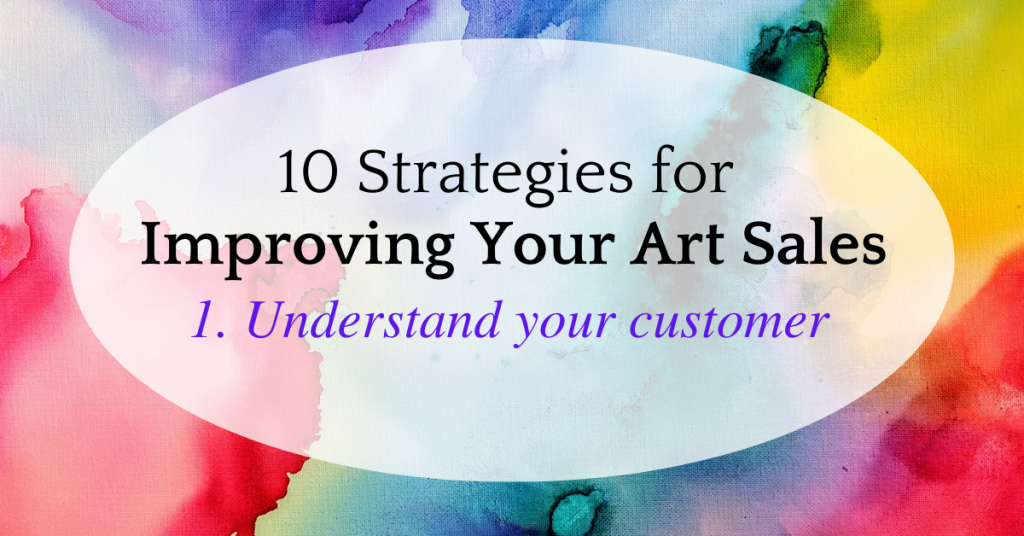This is a guest post from Carolyn Edlund of ArtsyShark.com. Carolyn and I have had several conversations wishing that we could help artists learn the actual skills of sales. In a former life, I was an annoying telemarketer. I learned all of these skills – the words to use, the way to ask for a sale without offending people, and how to project confidence in the transaction. Carolyn does a GREAT job here of breaking it down.
Are you lacking skills and technique when it comes to closing the sale? Try some of these strategies and watch your sales increase!

1. Understand your customer. Most people aren’t your customer. Accept that, and concentrate on the niche you are in. This helps you work selectively, speaking to your ideal prospects more easily, and converting them into customers.
2. Craft your message carefully. In order to sell more art, you must be able to speak clearly and powerfully about your work. What is your concept? What is your story, and why does it matter? What is truly unique and compelling about your work? How does that translate into something wonderful for them?
Creating your sales talk is something you will want to do in advance. Write down your story – then make it more concise, pulling out the most interesting facts. Use this time to truly identify the needs of your customer, and design your message to appeal to them emotionally.
You message should also focus on building the value of your work. Your customer isn’t buying something impersonal and manufactured. They are making a very special purchase, directly from the artist. Communicate value in your marketing materials, signage, through your display and in your verbal communications.
3. Ask questions. Find out what is important to your customer. What do they need and value? In this way, you can craft your sales presentation to create an emotional resonance with your customer, and you are also showing through your questions that you care about what they really want and need.
Rather than rattling off all the benefits of your work, listen to find which ones will be important to them. If you are speaking with an interior designer, you would certainly make a different presentation than if you were speaking to a parent seeking a portrait of their child, for example.
4. Prepare to deal with objections. Know possible objections going in, so that you can head them off before they happen. Will your customers think your work is too expensive? You may want to have a 100% satisfaction guarantee upfront, allowing a complete refund in the first thirty days. Will they be concerned about how to transport and install your work if it is heavy or cumbersome? Perhaps part of your presentation will explain that you provide these services. Are they concerned about cleaning of your creations? Hang tags and explanations of how to care for the item help relieve these worries.
5. Be consultative. Make recommendations on what to buy. Customers actually love this. It takes the burden of too many decisions off their plate, and makes the whole process easier. You are, after all, the expert on your own artwork. So share your knowledge. Encourage your customer to see you as an authority whose recommendations are valuable, rather than as a salesperson.
6. Convey a sense of ownership. This may mean that you pull out your iPad and scroll through “in situ” photos of your work in a home or office environment, to give them an idea of how it may work in theirs. Place the item they are considering in their hand, if possible. Use the senses to help them “experience” your work by encourage them to touch – or even listen, smell or taste what you are selling if that applies. Every one of the senses adds to their experience and to your opportunity to make the sale. Use phrases that give a sense of ownership, such as “your painting would look perfect on a dark blue wall.”
7. Offer a turnkey product. Is your painting ready to hang? Does your item come in a gift box? Is it packed well to fit easily in a suitcase? Do you offer shipping to a gift recipient? Any extra service or benefit you can offer that makes buying your work easier will earn you more sales.
8. Increase the ticket by cross-selling, upselling, and bundling your work. Your handmade necklace comes in sterling silver, but let them know that it can be made in gold as well. This is an upsell. It will also increase the price significantly, but it may also more perfectly fit their needs.
Cross-selling adds other related items to the sale that make sense, such as purchasing ceramic cups to go with that hand thrown teapot they want to buy. Bundling creates a package of your goods – such as a gift basket or set, which can make a bigger impact, especially if they are purchasing for someone else.
9. Ask for the sale. Keep a positive attitude about the sale, knowing that your interested prospect will get great enjoyment from and deserves to own a piece of your work. When you have gone over all the benefits, seen their reaction, and helped to create an experience for them and a sense of ownership, ask, “May I wrap this special piece of jewelry up for you?” or “Are you ready to schedule an appointment to have this your sculpture delivered to your office?” If you don’t ask, you can’t get a “yes.” And if the answer is no, it may mean that the sales cycle will take a little longer. Get their name, phone and email, and continue to follow up with them. Many sales happen after the initial contact.
10. Be honest, and serve your customer to the best of your abilities. Don’t make recommendations simply to sell what you have in stock, but take into account what is truly best for your customer. The most effective way to build your art business is through repeat sales. Earning satisfied customers, and even raving fans, is just about the best thing you can do for your own business. As you serve them, you also serve your own needs.
 Bio: Carolyn Edlund is the founder and author of Artsy Shark, a blog that inspires artists to build better businesses. Her background includes owning a production studio, working as an art publishing sales rep, and working as an art consultant. She writes extensively on business subjects for artists, and is currently the Executive Director of The Arts Business Institute. image credit Steve Alpert’s blog
Bio: Carolyn Edlund is the founder and author of Artsy Shark, a blog that inspires artists to build better businesses. Her background includes owning a production studio, working as an art publishing sales rep, and working as an art consultant. She writes extensively on business subjects for artists, and is currently the Executive Director of The Arts Business Institute. image credit Steve Alpert’s blog
Want more help with sales skills?
We’ve got you covered: start with your unique value proposition, then move on to body language and active listening. Then you’ll want to discover what you can learn from a door-to-door salesman, and finally incorporate all your new selling skills into a killer sales page on your website as well.
Great post, thanks Carolyn! Classic points, always good reminders.
Thought this was good advise; I’ve sold one of my paintings so far at Art Obsessions Gallery in Truckee and would love to know more about how it was marketed if at all. A few months have gone by where I should be selling more; there must be people who like my genre but haven’t seen my work. Any thoughts on this? Or how to have people see your website? Thanks! Suzan
Susan, you say you sold your work through a gallery but don’t know much about the sale – I’d advise you to be in touch with them regularly. Your gallery is a “partner” of sorts with you, and should be in communication with the artists. You in turn should help promote them, make artist appearances, mail upcoming events to your list, etc. That always helps to sell more work.
I think #1 might be the most important. I’m a copywriter not an artist {word artist, perhaps? ha ha ; ) }, but getting uber-clear on your ideal customer avatar makes every other part of your sales process so much easier and smoother!
Exactly dear..its true
Thank you for your response; I’ve made inquires and have ideas about how he can, probably triple his sales. Now someone is interested in my Cheetah painting, only on a smaller scale (the original is 7’x5′ for around 5k. The gallery really needs to hire someone to update the web site and take care of sales. I feel extremely fortunate that he took me. You mention something about a “list” . I only know that a woman bought Tashunka Warriors for a house being built in Lake Tahoe; should I be the one asking for her name? I do put my website address on the back of all my paintings. By the way, he feels that he can get 30k for my original Animal Planet Makes the Kill. I really don’t understand the interest in this one piece; “Insouciance” I feel is one of my best. Thank for taking the time to reply to me!
Susan aka Suzanartist.com
Made a mistake 30k for original and 5k for 36×48! Sorry!
Susan
Susan, when I refer to a “list” I mean a list of email addresses for people interested in your work. You may collect them on your website, by putting out a guest book at any art shows, or open studios or other events you attend. Cultivate your list and share information about yourself and your work regularly with them through newsletters, through inviting them to connect with you on social media and by attending your openings. As you sell work, keep in touch to encourage collectors to purchase more from you. This is an essential part of networking and marketing.
Thank you; I’ve not ever entered an art show. The gallery owner has tons of work and needs to have help. We don’t often communicate as he is so busy, but I have made inquires.
Thanks!
Susan
Thank you Carolyn for these great tips! Most artists aren’t sales professionals and this blog post gave some valuable insight on where to start. Finishing off with the most important tip, number 10, just trying to do your best and serving your client the best you can.
Hi, great article, I am preparing to launch a marketing attack and hopefully ready before Christmas, however I am very confused as what my costumer is? How do I find out? Thanks, Kiera
Where’ ll it be held from
Great article, thanks for sharing, I am pt. trying to built up my art career so all you wrote here have been very useful to me.
You can see my artwork here:
facebook.com/ArtByMikkelHansen
twitter.com/ArtMikkelHansen
artbymikkelhansen.com
Serving best according to your abilities will almost increase your sale however you can provide them best services at an affordable cost by installing the art without any extra cost although to improve the art sales you can also use some marketing help as marketing the product will almost help in increasing the sale.
Thank you for this blog post! I am a new artist (been painting the last 3 years) and decided I want to make some sales as a new years resolution!
Only thing is starting from scratch with no marketing skills and that little voice telling me I’m not good enough is really hard.
Harder still I can’t physically get out there into the world due to ‘lockdowns’.
I’m going to really work on your points and make a plan. Fingers crossed!